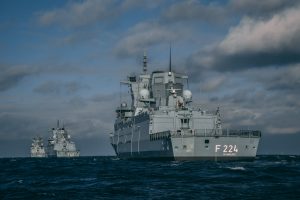Class 125 frigate "SACHSEN-ANHALT" put into service in Wihelmshaven

Almost two years after the "Baden-Württemberg" (F222) and eleven months after the "Nordrhein-Westfalen" (F 223), the German Navy will commission the third frigate of the F125 class on 17 May 2021. Like her sister ships, the "Sachsen-Anhalt" (F 224) will belong to Operational Flotilla 2 at the Wilhelmshaven naval base. "I am very pleased about the commissioning of the third of four units. We urgently need the unit to relieve our existing units of obligations on the one hand and to use this platform to train our crews due to the lack of training infrastructure ashore on the other," explains Flotilla Admiral Ralf Kuchler, Commander of Operational Flotilla 2. Due to the current Covid-19 situation, the "Sachsen-Anhalt" was commissioned in a small group. Guests included Reiner Haseloff, Minister-President of the ship's sponsor state, Eva Högl, Parliamentary Commissioner for the Armed Forces, and Siemtje Möller, Member of Parliament and defence policy spokesperson for the SPD parliamentary group in the Bundestag.
A project with challenges
The F125 frigate armaments programme is the sad frontrunner in the current armaments report from the Ministry of Defence in terms of systems that have run out of control compared to the financial planning. Compared to the 25-billion-euro bill approved by the Bundestag, the project has become 1.117 billion euros more expensive. This corresponds to an increase of 51 per cent.
On 20 June 2007, the Bundestag Budget Committee approved the construction of the four F125 class frigates at a cost of 2.6 billion euros. Construction of the type ship began on 9 May 2011. The "Sachsen-Anhalt" was officially launched in Hamburg on 4 March 2016 by the wife of the Minister President of the State of Saxony-Anhalt. Reiner HaseloffGabriele Haseloff, was baptised.
According to the German government's 12th Armaments Report, completion of the F125 frigate has been delayed by 67 months compared to the planning at the time of parliamentary referral. This corresponds to an increase of 73%. The delay - the 8th Armaments Report spoke of 51 months - is due to a change in the calculation: whereas the start of delivery used to be the cut-off date, it is now the initial operational capability. Compared to the 11th Armaments Report from spring 2020, the delay has been reduced by 38 months! One of the reasons for this is that new delivery dates have been agreed.

Due to the required intensive utilisation (i.e. two years in service, 5,000 operating hours per year, worldwide deployment; operational maintenance period standard (BEPN) 68 months, implementation of a two-crew concept), the operational management and maintenance of the ship and equipment with a simultaneously small crew size (crew of 120 men and women) are of great importance. This required new technical concepts for the maintenance and preservation of functionality as well as for the design of the operated systems. Many of the systems and subsystems are new developments and have been customised for this class. For example, 28,000 sensors enable the very high degree of automation. The CODLAG propulsion system, in which the electric traction motors are powered by diesel engines, is a new introduction in the navy. The challenge is underlined by the impressive number of change requests. The 12th Armaments Report from December 2020 lists 194 amendments.
Classification of cost increases and delays
Cost increases for armaments programmes are due to changes in performance, contractually agreed price escalation, conversion of the price type, exchange rate changes and non-attributable causes. The Federal Ministry of Defence's 12th report on armaments matters (December 2020) lists cost increases of 7.994 billion euros due to price escalation for all armaments programmes. In addition, performance improvements and changes to performance for all armaments projects add up to around 3.339 billion euros. These changes are based on additional services in response to military and technological developments during the procurement process. In principle, the financial requirement can also be reduced, for example if an original requirement is cancelled or if it is not technically feasible. Non-attributable causes result in an additional requirement of 1.669 billion euros.
The deviation in the current budgetary mapping of all current armaments projects analysed in the 12th Armaments Report amounts to 13.745 billion euros in 2020, which is around 271,000,000 euros compared to the original estimates for the projects at the start of the project - i.e. the first 25-billion-euro proposal). For example, the costs for the A400M transport aircraft, which was approved by the Budget Committee in 2003, increased by 1.627 billion euros, which corresponds to an increase of 19%. The cost of the Eurofighter, which was discussed in parliament in 1988, increased by 7.671 billion euros - that is. 29%. The cost of the Puma, which was approved by parliament in 2002, rose by 1.393 billion euros - equivalent to 36%. The cost of the NH90 TTH, which went through parliament in 2000, rose by 1.331 billion euros - that's almost a third, or 32%.
The development and procurement time for the defence projects will take 53 months longer than stated during the first parliamentary debate (as of October 2020). The A400M has a delay of 148 months (an increase of 176%), the NH90 TTH - 134 months (106% more), the Puma - 61 months (38% more than originally calculated).
Photos: German Navy/4th FGschw
Details of the Baden-Württemberg class (F 125)
| Units: |
|
| Length: | 149,6 m |
| Width: | 18,8 m |
| Depth: | 5,4 m |
| Maximum speed: | >26 kn |
| Drive: | CODLAG (Combined Diesel-eLectric And Gas Turbine) |
| Displacement: | approx. 7100 tonnes |
| Crew: | max. 190 people (including up to 120 regular crew) |
| Sensors: |
|
| Effectors: |
|










